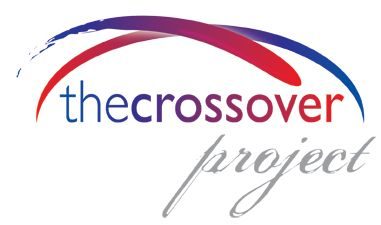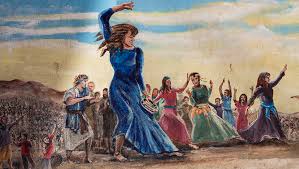The Old Testament is the first part of the Bible, and so we must turn to this in order to understand the role of dance in Jewish culture. There are twenty-two references to dance in the Old Testament, mostly in a positive way, but in a few cases in a negative way. There is a Hebrew word chag, which means circle, and the word for feast in Hebrew is chagag, which depicts dancing/moving in a circle (e.g. Exodus 5:1, Exodus 12:14, Leviticus 23:41, Numbers 29:12, Deuteronomy 16:15). Jewish people still do this dance circle today at weddings and at Sukkot (Tabernacles), Pesach (Passover) and Shavuot (Pentecost).
After the great victory at the Red Sea after Passover we are told that the women danced in celebration:
When Pharaoh’s horses, chariots and horsemen went into the sea, the Lord brought the waters of the sea back over them, but the Israelites walked through the sea on dry ground. Then Miriam the prophetess, Aaron’s sister, took a tambourine in her hand, and all the women followed her, with tambourines and dancing. Miriam sang to them.
(Exodus 15:19-21)
Celebration of God’s victories seemed to be a cause for much rejoicing and dancing, as another Scripture also illustrates:
When the men were returning home after David had killed the Philistine, the women came out from all the towns of Israel to meet King Saul with singing and dancing, with joyful songs and with tambourines and lutes. As the danced, they sang: ‘Saul has slain his thousands, and David his tens of thousands’
(1 Samuel 18:6-7)
At the festival at Shiloh the women danced (Judges 21), and King David, danced before the Lord because the Ark of the Covenant was being brought back:
David, wearing a linen ephod, danced before the Lord with all his might, while he and the entire house of Israel brought up the ark of the Lord with shouts and the sound of trumpets. As the ark of the Lord was entering the City of David, Michal daughter of Saul watched from a window. And when she saw King David leaping and dancing before the Lord, she despised him in her heart. They brought the ark of the Lord and set it in its place inside the tent that David had pitched for it, and David sacrificed burnt offerings and fellowship offerings before the Lord
(2 Samuel 6:14-17)
King David was a musician who radically transformed the music and worship amongst God’s people and today we still speak of Davidic Dancing when we mean a joyful celebration of God’s victories. Several of his Psalms share this joy with us:
Let them praise his name with dancing and make music to him with tambourine and harp.
(Psalm 149:3)
Praise him with tambourine and dancing.
(Psalm 150:4)
Jeremiah also encourages dancing during victory times:
Again I will build you, and you shall be rebuilt, O virgin of Israel! Again you shall take up your tambourines and shall go forth to the dances of the merrymakers.
(Jeremiah 31:4)
Hear the word of the LORD, O nations. And declare in the coastlands afar off, and say, He who scattered Israel will gather him, and keep him, as a shepherd keeps his flock…Then the virgin shall rejoice in the dance, and the young men and old together: for I will turn their mourning into joy, and will comfort them, and give them joy for their sorrow.
(Jer. 31:10-13)
Dance, in biblical Jewish thinking, seems always to be practiced as part of a celebration of God’s victory, as Solomon expresses:
There is a time for everything, and a season for every activity under heaven… a time to mourn and a time to dance
(Ecclesiastes 3:1,4)
On the other hand we see several occasions in the Old Testament in which dancing is seen as sinful because of the association with it. For example, the Israelites had backslidden into paganism at the time of Moses going up to receive the Ten Commandments from God. He had been away a long time so the people made a golden calf like the pagans around them and began to celebrate and make merry with dancing to this idol. Moses was angered by this rapid fall into idolatry:
When Moses approached the camp and saw the calf and the dancing, his anger burned’ (Exodus 32:19)
It was not the dancing that caused Moses’ anger to burn but the worship of a false god. It is likely too that the type of dancing associated with paganism was sensual and immodest and out of place with God’s people.
The second occasion was when the Israelites ended up worshipping the pagan god called Baal, a fertility god. There had been a wholesale backsliding of the nation into idolatry to such an extent that the Baal prophets and priests became their leaders. This was why God was angry with the people. A scene is described from the event in which Elijah, his prophet, challenged them:
They took the bull given them and prepared it. Then they called on the name of Baal from morning till noon. ‘O Baal, answer us!’ they shouted. But there was no response; no one answered. And they danced around the altar they had made
(1 Kings 18:26)
by Paul James-Griffiths | Aug 20, 2016 | The History of Dance in the Church




